Why this resume works
- Quantifies accomplishments: Measurable accomplishments, like a 40% increase in followers, highlight the applicant’s significant impact on social media growth.
- Highlights industry-specific skills: Industry-specific skills, such as managing high-budget ad campaigns and executing successful content strategies, illustrate the applicant’s fit for digital marketing roles.
- Showcases career progression: Career progression is evident through increased responsibility from content coordinator to social media manager, showcasing growth and leadership in digital engagement.
More Social Media Manager Resume Examples
Explore our social media manager resume examples to learn how to highlight your strategic skills and digital marketing experience. These marketing resume samples will help you craft a compelling resume that attracts employers.
Entry-Level Social Media Manager
Why this resume works
- Centers on academic background: Drawing attention to academic achievements like graduating with honors showcases the applicant’s strong educational foundation, which complements early-career roles in digital marketing and communications.
- Shows digital literacy: By listing tools such as SEO optimization and CRM systems, the applicant highlights practical computer skills essential for thriving in tech-driven workplaces.
- Effective use of keywords: Including role-specific keywords like social media strategy and audience engagement ensures alignment with ATS requirements.
Mid-Level Social Media Manager
Why this resume works
- Points to measurable outcomes: By consistently achieving metrics like a 30% boost in social following, the applicant effectively illustrates their ability to drive measurable results in digital marketing roles.
- Demonstrates language abilities: Language skills in Spanish improve the applicant’s potential for cross-cultural communication and expanding international market reach.
- Includes a mix of soft and hard skills: Combining technical expertise with strong interpersonal skills, the applicant navigates both data analytics and community engagement, offering a comprehensive skill set.
Experienced Social Media Manager
Why this resume works
- Focuses on work history: Using a chronological resume format, the applicant’s extensive career showcases growth from content marketing specialist to social media manager, emphasizing their strategic development.
- Lists relevant certifications: Listing Google Analytics and Facebook Blueprint certifications demonstrates commitment to staying updated in digital trends and improving marketing effectiveness.
- Showcases impressive accomplishments: By highlighting accomplishments like spearheading a campaign that increased conversions by 35%, the applicant’s accomplishments reflect powerful contributions and senior-level expertise.
Social Media Manager Resume Template (Text Version)
Aya Zhang
St. Louis, MO 63110
(555)555-5555
Aya.Zhang@example.com
Professional Summary
Experienced Social Media Manager with proven track record in boosting engagement and managing high-budget campaigns. Skilled in content creation, SEO optimization, and community management.
Work History
Social Media Manager
DigitalWave Marketing – St. Louis, MO
August 2023 – August 2025
- Increased followers by 40% in 12 months
- Managed $50K annual ad budget
- Executed campaigns with 15% conversion
Online Community Manager
BuzzSocial Media – St. Louis, MO
April 2020 – July 2023
- Boosted engagement by 25%
- Developed content strategy
- Monitored analytics and KPIs
Content Coordinator
NextGen Creative Solutions – Parkview, MO
August 2018 – March 2020
- Generated $10K in ad revenue
- Created a monthly newsletter
- Managed brand collaborations
Skills
- Social media strategy
- Content creation
- Analytics and reporting
- Ad campaign management
- SEO optimization
- Community engagement
- Brand development
- Digital marketing
Education
Master’s Degree Digital Marketing
Stanford University Stanford, California
June 2018
Bachelor’s Degree Communications
University of Washington Seattle, Washington
June 2016
Certifications
- Certified Social Media Manager – Digital Marketing Institute
- SEO Expert Certificate – Google
Languages
- Spanish – Beginner (A1)
- French – Beginner (A1)
- German – Intermediate (B1)
Related Resume Guides
- Communications Specialist
- Community Manager
- Content Manager
- Conversion Optimization Specialist
- Digital Marketing Executive
- E-Commerce Business Analyst
- E-Commerce Marketing Manager
- Marketing Coordinator
- Marketing Manager
- Marketing Officer
- Media Planner
- Merchandising Associate
- Online Campaign Manager
- Pricing Analyst
- Product Manager
- Public Affairs Specialist
- Public Relations Officer
- Search Engine Optimizer
- Sponsorship Executive
- Strategic Accounts Manager
- Technical Marketing Manager
- Trade Marketing Manager
Advice for Writing Your Social Media Manager Resume
Crafting a standout resume for a social media manager role can set you apart in this dynamic field. Dive into our tailored advice on how to write a resume specifically for social media professionals. Learn how to spotlight your creativity, digital prowess, and ability to engage online audiences effectively.
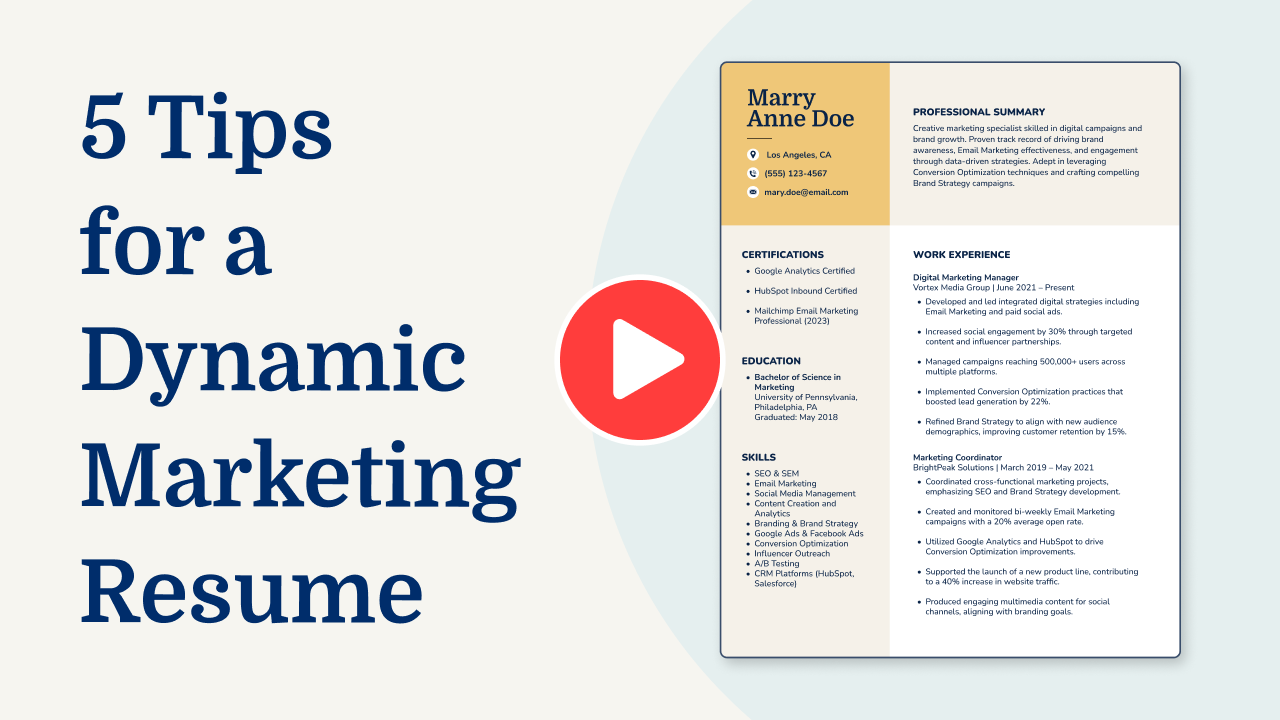
Showcase your portfolio or projects
Creating a portfolio or projects on your resume is important for artistic and creative roles, like a social media manager. It lets you show what you can do, rather than just telling people about it.
When you link to your online portfolio on sites like Behance, Dribbble, or your personal website, employers can see firsthand the quality of your work. Including select projects in your resume also adds depth and context to your skills.
For social media managers, showcasing freelance work, academic projects, and side projects is valuable. These examples highlight your ability to handle different types of clients and challenges.
Structure each project detail similarly to work experience entries by including the project name, the client or company (if applicable), a brief description of the work, and key contributions along with their impact. This format makes it easy for employers to understand what you did and how it benefited the project.
Having concrete examples in your portfolio shows potential employers that you have real-world experience in managing social media accounts successfully.
Whether it’s growing followers for a small business or running a campaign for an academic group, these examples prove that you’ve put theory into practice effectively.
Example of a projects section
Social Media Campaign for Eco-Friendly Products
GreenLeaf Solutions
March 2023 – June 2023
- Developed and executed a month-long Instagram campaign, increasing follower count by 30%.
- Collaborated with influencers to boost brand visibility and engagement.
- Analyzed campaign metrics and adjusted strategies to improve reach.
Content Strategy for Non-Profit Organization
Helping Hands Initiative
August 2022 – November 2022
- Created a content calendar that increased social media engagement by 50%.
- Managed Facebook ad campaigns targeting donor acquisition, resulting in a 20% increase in donations.
- Coordinated cross-platform content distribution for consistent messaging.
Get inspired and save time by checking out our professional resume examples. They help you see how to organize your skills and experience clearly.
Emphasize your most relevant skills
In the role of a social media manager, both technical and soft skills play a big part in success. Technical skills include knowing how to use software like Hootsuite or Adobe Creative Suite, which help manage and create content.
Soft skills, such as communication and creativity, are just as important because they help build strong connections with audiences. Highlighting these skills in your resume shows you’re ready for the creative challenges of the job.
A good way to show off your skills is by having a dedicated skills section on your resume. Here, you can list software tools you’re familiar with and any artistic talents you have, like graphic design or video editing. This makes it easy for anyone reading your resume to see what you bring to the table at a glance.
To make your resume even stronger, weave these skills into your work experience bullet points. For example, if you’ve used Photoshop to create engaging social media posts that boosted engagement by 20%, mention it. This gives real examples of how your skills have helped achieve success in past roles and paints a clear picture of what you can do as a social media manager.
A resume format highlighting social media strategy, audience engagement, and campaign results can effectively showcase your qualifications as a manager.
Choose a professional resume template
When choosing a resume template for a social media manager role, aim for one that mixes creativity with professionalism. Templates that are clean and well-structured help your experience and skills stand out without clutter or excessive design elements.
A strong template should feature a clear visual hierarchy to make it easy for hiring managers to locate key information quickly. Avoid fonts or colors that are overly decorative, as they can distract from the content of your resume.
It’s equally important to choose a format optimized for compatibility with applicant tracking systems (ATS). Many companies rely on these systems to screen resumes initially, so using layouts with straightforward designs and standard font types like Arial or Times New Roman is essential.
This approach ensures both recruiters and software can easily process your resume. By prioritizing simplicity and clarity, you improve the chances of showcasing your abilities effectively as a social media manager while making sure your resume ends up in front of the right people.
Using our Resume Builder makes crafting your social media manager resume easy. Pick a template and customize it to highlight your skills with visuals and concise text.
Format your resume properly
A proper resume format ensures your social media manager application is easy to read and looks professional. Strong experience in managing campaigns or content creation calls for a chronological format to highlight career growth and past roles. If you’re newer to the field, you can use a functional format to showcase transferable skills like creativity or analytics without focusing heavily on work history.
5 resume formatting tips
- Use clear section headings: Structure sections with headings like “work experience” and “skills” for clarity.
- Select a readable font: Choose fonts like Arial or Calibri, size 10-12 pt, for easy reading.
- Implement bullet points: Present skills and achievements in bullet points for quick scanning.
- Aim for one page length: Keep your resume to one page unless you have extensive experience.
- Ensure proper spacing and alignment: Use consistent margins and spacing to maintain a professional appearance.
Make sure your resume stands out to ATS software! Use our ATS Resume Checker to find the best keywords and formatting so your resume gets noticed by employers.
FAQ
Do I need to include a cover letter with my social media manager resume?
Yes, including a cover letter with your social media manager resume is important for making a strong impression.
A cover letter lets you express your enthusiasm for the company and role, highlighting your unique skills in content creation and audience engagement.
For instance, if a company prioritizes innovative campaigns or has a strong focus on analytics, discuss your experience with successful social media strategies in those areas.
Our Cover Letter Generator can help craft a personalized cover letter by offering expert tips and guidance tailored to your needs.
You might also find it helpful to look at our collection of cover letter examples, which provide insights into crafting effective letters across various industries.
How long should a social media manager’s resume be?
For a social media manager, a one-page resume is often sufficient to highlight key skills such as content creation, analytics skills, and platform management. This format helps you present your most relevant experiences and achievements concisely.
However, if you have extensive experience or multiple successful campaigns that showcase your expertise, a two-page resume might be more suitable. Just ensure every detail included directly supports the role of social media management.
You can also review our guide on how long a resume should be for tips tailored to different career stages.
How do you write a social media manager resume with no experience?
If you’re creating a resume with no experience for a social media manager role, highlight your transferable skills, personal projects, and relevant education to show your potential in this field. Here are a few tips to help you get started:
- Highlight personal or volunteer projects: If you’ve managed your own social media accounts or helped friends, clubs, or nonprofits grow their online presence, include these as real-world examples of your skills.
- Focus on relevant coursework: Mention classes like marketing, communications, or digital media that taught you about audience engagement, analytics, or content creation.
- Showcase transferable skills: Highlight abilities like creativity, writing skills, data analysis (e.g., using Google Analytics), and familiarity with platforms such as Instagram, TikTok, or LinkedIn.
- Include certifications: Add free or affordable certifications from platforms like HubSpot Academy or Coursera in areas like social media strategy or content marketing.
By tailoring your resume with no experience this way and emphasizing your passion for social media management along with any hands-on learning you’ve done independently, you’ll stand out to hiring managers ready to invest in entry-level talent.
Rate this article
Social Media Manager
Additional Resources

25 Interview Questions for Managers (With Answers & Tips)
Success in a management interview starts long before the conversation begins. Taking the time to prepare thoughtful responses to common interview questions for managers helps you clearly communicate leadership experience
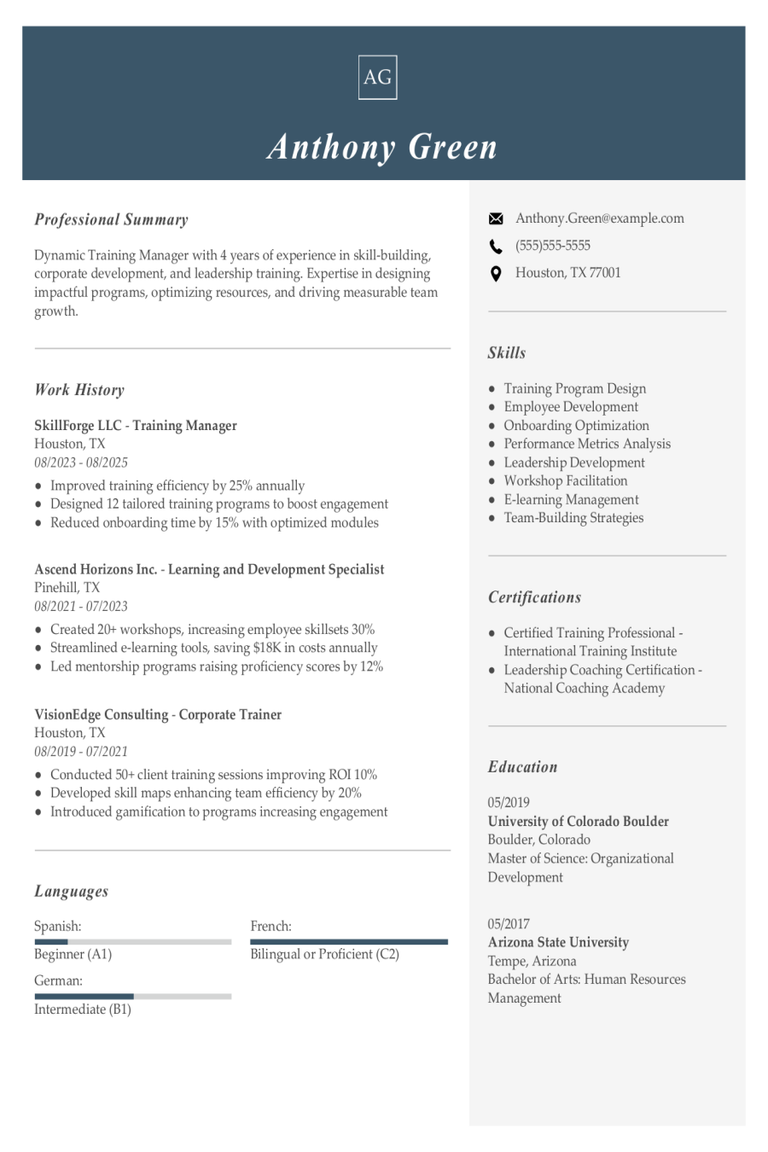
Training Manager Resume Examples & Templates for 2025
Discover how training managers showcase their skills in leading workshops and improving employee performance on their resumes. Our examples and tips will help you craft a resume that stands out
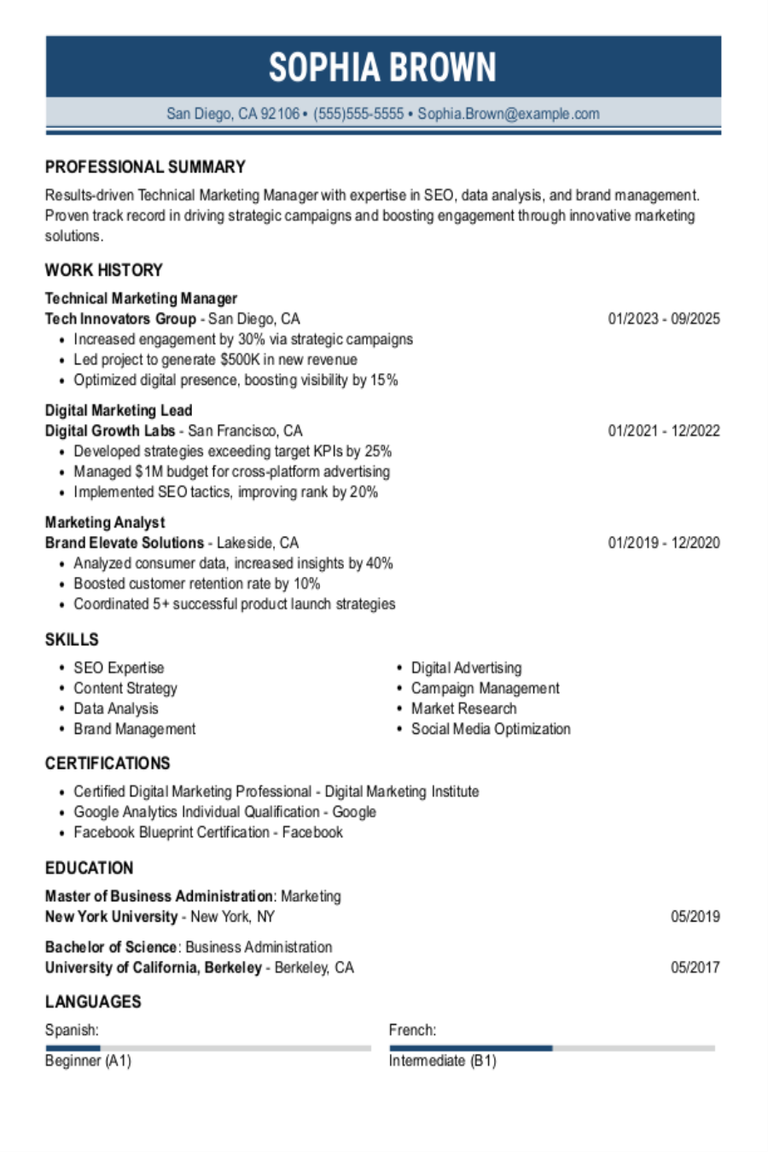
Technical Marketing Manager Resume Examples & Templates for 2025
Discover how to craft a technical marketing manager resume that shines. Learn to highlight your tech-savvy skills, marketing strategies, and project successes effectively.Build my resumeImport existing resumeCustomize this templateWhy this
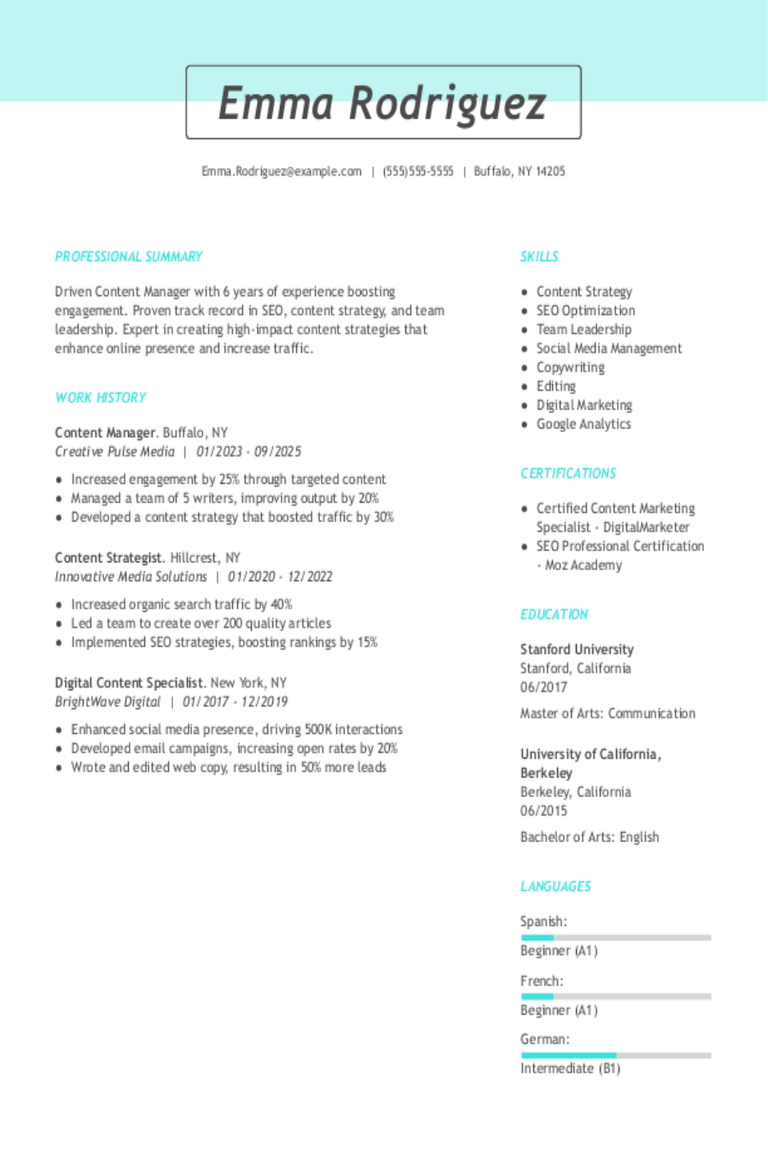
Content Manager Resume Examples & Templates for 2025
Browse content manager resume examples to see how to highlight your experience organizing, creating, and sharing engaging materials across platforms. These examples and tips help you showcase creativity, leadership, and
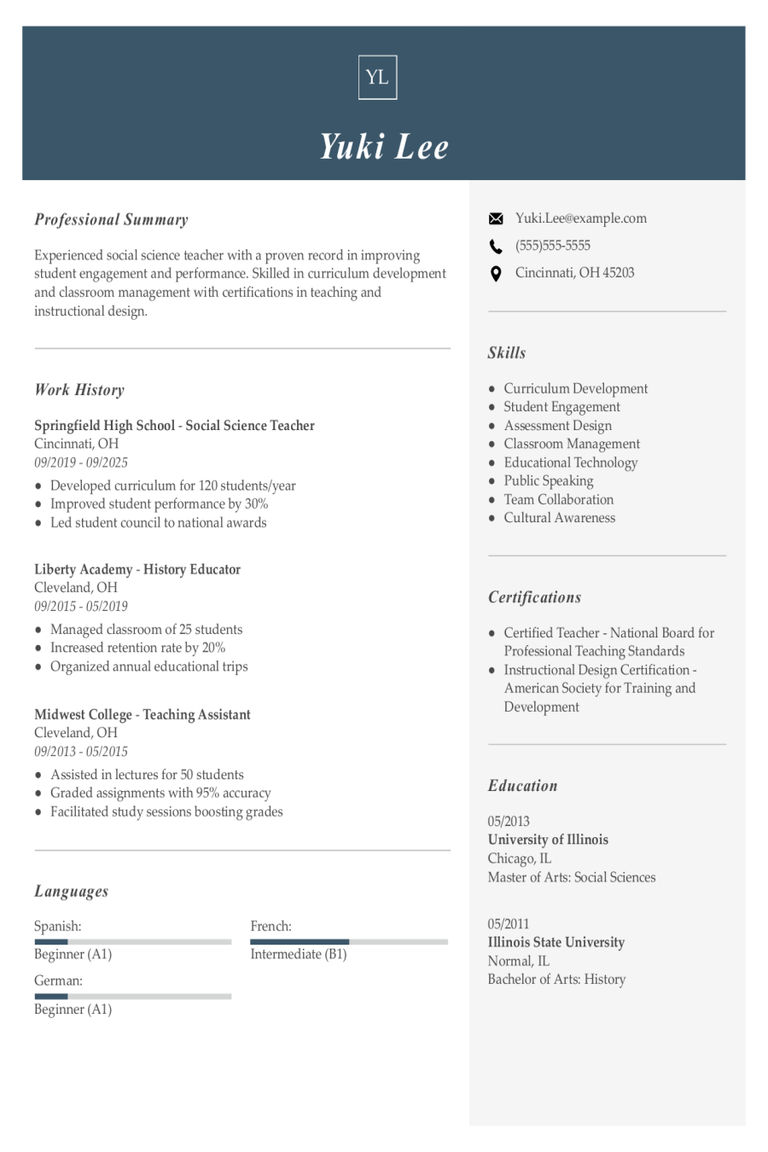
Social Science Teacher Resume Examples & Templates for 2025
Discover how social science teachers can showcase their classroom expertise and ability to engage students. These resume examples and tips will help you highlight your lesson planning skills and experience
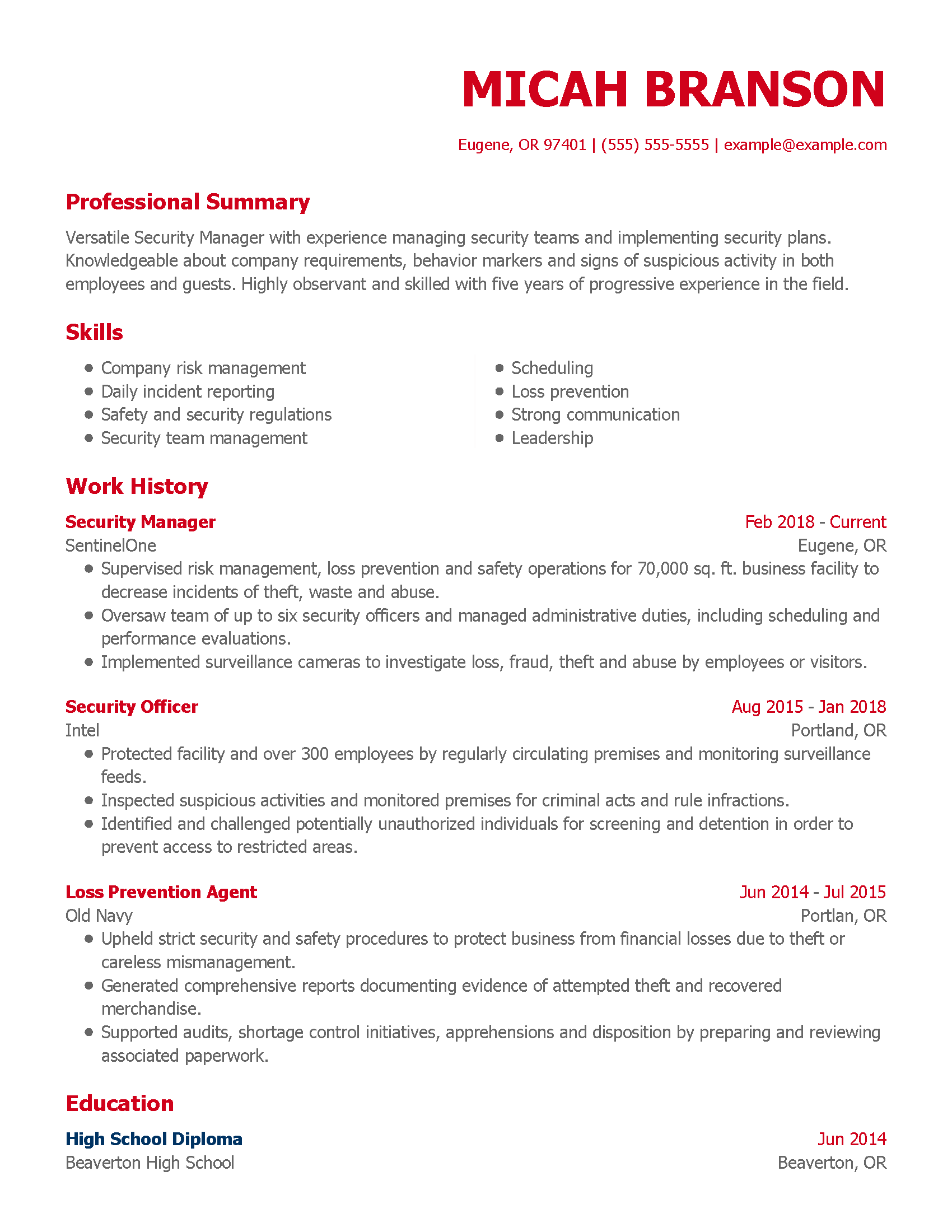
Security Manager Resume Examples & Templates for 2025
Explore security manager resume examples that showcase leadership, emergency response, and risk management. Get tips to highlight your skills and experience in keeping people and property safe.Build my resumeImport existing
